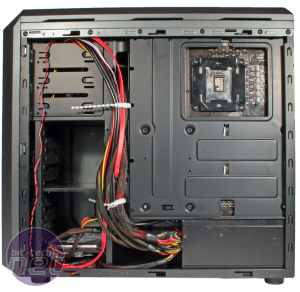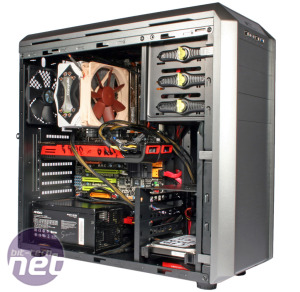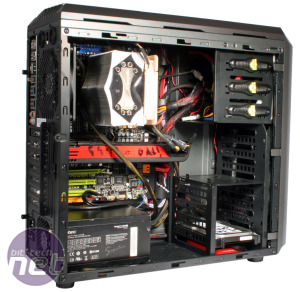
Performance Analysis
With the fans on low speed, the G7 doesn't inspire much confidence in its cooling potential. We see the CPU climb all the way to a delta T result of 60°C; one of the highest we've seen. Airflow from the single exhaust fan clearly isn't enough to cope here, and the whole area around it warms up significantly even after just fifteen minutes, with the ventilated roof seemingly ineffective at dispersing heat too. Meanwhile, the GPU levels out at a delta T of 53°C, which is on par with the Midgard II also at minimum speed. The restrictive front panel means that both the graphics card and CPU are starved of a fresh supply of cool air, despite being the side panel providing good ventilation for the GPU.In terms of noise, it's easy to hear the noise from our case hardware, especially the graphics card fan, as the thin metal and ventilated side panel and roof do little to subdue the resultant noise. When the fans are on low speed, it's near impossible to make them out over everything else, but activating Turbo mode changes this, with both fans producing their own hum and adding to the overall noise, which could become a little intrusive with louder hardware than ours installed.


Click to enlarge - Cables are easy to move out of the way of airflow, but overall the look isn't as clean as it could be
Thankfully, an increase in noise levels isn't the only change that Turbo mode brings about, as switching the fans to this higher speed results in temperatures that are much healthier, although still not particularly impressive. The CPU drops by 6°C to a delta T of 54°C, which is just a little behind the Midgard II at its own highest speed - the exhaust fan is clearly more effective at higher speeds.
With the fans on fall speed, the GPU temperature also improves, but this time only by 3°C, again showing that the front fan has a harder time shifting air thanks to the solid front panel. Comparatively, Nanoxia's Deep Silence 2 achieves better temperatures here whilst being much quieter, whereas the similarly priced Midgard II sheds a lot more from its GPU temperature at maximum speed thanks to its front mesh that gives cool air a direct path into the chassis.
Conclusion
From our standpoint, the G7 is a step in the right direction for In-Win. The design is very toned down compared to what we're used to: for once its chassis doesn't look like an early Transformer prototype. Not only that, but for the most part, the feature set is seriously good for a £55 case. Like the Midgard II, it comes with fan control, USB 3.0, dust filters and even a hot-swap drive mount. The cable channelling is also decent considering the price, but it's a shame that there's no roof water-cooling support whatsoever. A few signs of weakness are apparent here and there when it comes to build quality, but there are no deal-breaker issues.However, the cooling performance to noise output ratio is a little disappointing, and we'd definitely feel more comfortable with an extra fan fitted and perhaps a slight mod to increase air flow from the front, but again the G7 is far from incapable in this arena. All things considered, it's a very respectable and feature rich budget offering that will house and cool your hardware well enough for a fair price, so if you're taken by its design there should be little to stop you going for it.
-
Cooling17 / 30
-
Features16 / 20
-
Design23 / 30
-
Value17 / 20


MSI MPG Velox 100R Chassis Review
October 14 2021 | 15:04










Want to comment? Please log in.